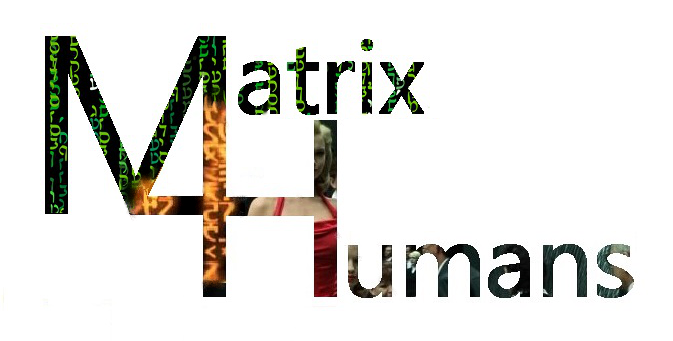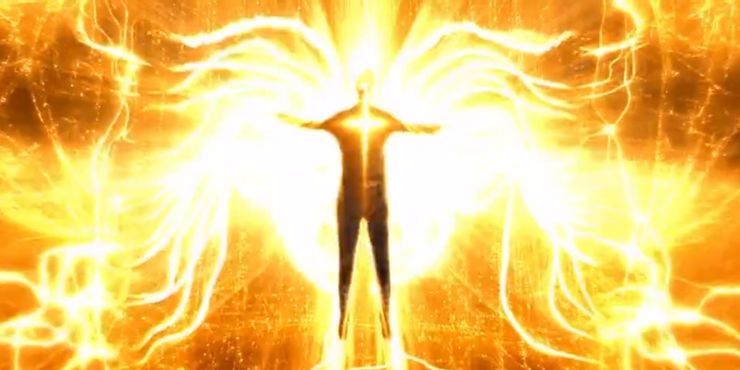As we discuss in the very first article in our Knowledge Base, there are aspects of many religious, philosophical, and psychological systems reflected in the Matrix films that will likely continue in The Matrix Resurrections. The result is a universal appeal that has continued for over 20 years. With this in mind, we are presenting an interesting connection between the characters of the Oracle and Sati, as found in the Hindu spiritual path. (Not to mention, Priyanka Chopra will be cast in a related role!) More information on each is found in our Knowledge Base.
There are several significant female characters in The Matrix films. Among them are two who have a peculiar relationship, those being the Oracle and the little girl, Sati. It is peculiar in that within the storyline, Sati’s parents, Rama Kandra and Kamala allegedly betray the Oracle in order to save her. Yet the young girl ends up being watched over by her.
We see them together twice in the final movie, Matrix Revolutions. Once in the kitchen of the Oracle, making cookies. The other at the very end of the film, talking about Neo’s potential return which will come in The Matrix Resurrections.
Shakti the Hindu Mother Force
The relationship between the Oracle and Sati, bears resemblance to two female figures in Hindu lore – Shakti and Sati.
Shakti represents the idea of the Divine Mother, in a similar manner to the Oracle does. Both relate to the feminine ‘aspect’ of existence in kabbalah. The ‘head’ (spiritual force) of what is called the left side or feminine ‘pillar,’ has multiple manifestations within our physical world.
Such expressions are ‘neutral’ in essence and can manifest as either beneficial or harmful. Hindu teachings express this same idea as follows:
Shakti also refers to the manifestations of this energy, namely goddesses. Some goddesses embody the destructive aspects of shakti, such as death, degeneration, and illness, while other goddesses embody the creative and auspicious powers of shakti, such as nature, the elements, music, art, dance, and prosperity.
Shakti, the Power of the Feminine, Jean Johnson
As the “upper feminine” dimension, Shakti resembles the kabbalistic concept of the Shekinah (the “divine presence”). Both are considered the ‘womb’ of creation, and “mother to all” as well as associated with the concepts of change and freedom.
This is similar to the idea of the Oracle, who is called the ‘mother’ of the Matrix, by the Architect in The Matrix Reloaded.
Another aspect shared between Shakti and the Oracle is how, through her, “the one becomes the many.” In the Matrix, this is the connection that a ‘freed’ human begins to feel toward others.
The person moves from “self-centeredness,” to higher consciousness and a state of self-abnegation. This is called Bittul in Kabbalah and Nishkam Karma in the Hindu faith.
This path involves a continual process of ‘restriction’ of one’s false perception of reality. This is a main theme to The Matrix story and the character of Neo who is guided to his destiny by the Oracle/Mother.
Rather amazingly, this feminine aspect of divinity in Hindu thought is described in terms that further resemble the Oracle, including being instrumental in someone returning to “the Source”:
“Through the power and grace of the Divine Mother we may be released from the darkness of ignorance and taken to the abode of knowledge, immortality, and bliss–the source from which we have come.”
Shakti: Realm of the Divine Mother, Vanamal
Another startling connection to the Matrix story, is how Shakti is said to be the ‘active’ half of the great divine power, working in unison with the half seeking tranquility.
Sakti [shakti] means “power”; in Hindu philosophy and theology sakti is understood to be the active dimension of the godhead, the divine power that underlies the godhead’s ability to create the world and to display itself. Within the totality of the godhead, sakti is the complementary pole of the divine tendency toward quiescence and stillness. It is quite common, furthermore, to identify sakti with a female being, a goddess, and to identify the other pole with her male consort. The two poles are usually understood to be interdependent and to have relatively equal status in terms of the divine economy.
Hindu Goddesses: Visions of the Divine Feminine in the Hindu Religious Tradition, David R. Kinsley
This is precisely how the Oracle (mother of the Matrix) relates the character of the Architect (father of the Matrix) who is portrayed in terms of his desire to solve equations and keep things nicely in balance.
Conversely, the Oracle makes clear that her purpose complements that of the Architect:
Oracle: That’s his purpose: to balance an equation.
Neo: What’s your purpose?
Oracle: To unbalance it.
Sati is Shakti in Our World
This is where it gets even more interesting.
The goddess Shakti chose to manifest in the physical world as a daughter to a worthy couple as a reward for their faithfulness. The name of this child was Sati. Thus, Shakti and Sati share a common ‘root’ while maintaining different roles, one ‘above’ and one ‘below.’
The same applies to the concept of the “divine presence” (Shekinah) in kabbalah, which has an upper and lower dimension to it. Just as Shakti can take on many forms within creation, the same applies to the Shekinah, which in different texts is called; mother/daughter, wife/bride and queen/princess.
Whereas the character of Trinity fulfilled the wife/bride aspect in her relationship with Neo, Sati’s role is/will be, one of the daughter, who in kabbalistic stories, is separated and lost in the world. Note how her ‘father’ Rama Kandra expresses how much he loves his ‘daughter,’ yet must send her “into exile,” in The Matrix Revolutions.
As we’ve posted in a few places, including the Rama Kandra blog, there is something ‘hidden’ within Sati that has to do with her entry into the Matrix world from ‘beyond.’ As an aspect of the divine presence, she will have a special role with the people, especially in the lives of those seeking ‘truth’ in The Matrix Resurrections.
‘Truth’ happens to be the root of the word ‘sati.’ No doubt, the next movie will have a greater element of ‘truth’ as we enter the realm of what is called the ‘fourth level of the soul’ – Chaya – which is the level of “seeing the absolute truth of things.”
Another meaning to the term sati is “virtuous.” This reflects the concept of the “virtuous woman,” from Proverbs, chapter 31 in the Bible, which is also associated with the feminine Shekinah.
This aspect of feminine energy in Hinduism is responsible for not only the creation and maintenance, of the universe but inevitably its destruction – albeit for “good purpose.” A similar concept is found in kabbalah in terms of the present “heavens and earth” being destroyed and formed anew.
Amazingly, this was revealed in a scene not used in the trilogy. Once you see this, you will understand why Sati is returning in The Matrix Resurrections!
Note that in this clip, the Oracle clearly states that what Sati’s parents did (‘betraying’ her) was, in fact, not what it seemed. It was done out of love and for the greatest cause.
Not only that but there is one key line, in fact, a single WORD from Rama Kandra that reveals that the Oracle was “in on everything,” from the beginning. (Something we have yet to find anywhere else on the Internet over 18 years!)
He told this to Neo.
I consulted with her BEFORE I met with the Frenchman.
Thus, Rama Kandra and Kamala fit the role of ‘faithful’ parents in the Shakti narrative mentioned above.
As for the Oracle not having any problem with what they did, recall what she told Neo in The Matrix Reloaded:
“We’re all here to do what we’re all here to do. I’m interested in one thing, Neo, the future. And believe me, I know – the only way to get there is together.”
Regarding The Matrix Resurrections, the question on the minds of many is, “Will actress Priyanka Chopra play an older Sati?”
We have been posting articles (and teaching classes) on the return of Sati for years, including Rama Kandra’s blog post from last year on Priyanka Chopra.
So our answer is this:
If the Matrix story continues along the same path it has for the first three movies, then Yes, Sati HAS to return. In fact, Sati is the critical piece regarding what has to happen in the next stage of the redemption of humanity in the Matrix story.
As this article shows, the characters of Sati and the Oracle are not so far apart. As with the Oracle, Sati will desire ‘one thing’ – the fulfillment of the Matrix prophecy and freedom for the people.
Remember what the Oracle said about being interested in one thing – the future. Sati was sent along to be in that future.
There will be a struggle involved – a final ‘battle’ between Sakam and Nishkam Karma. Self-centeredness and selfless love. Sati represents the latter. Her ‘adversary’ and the battle between what each represents is revealed in our Knowledge Base!
<< Follow the White Rabbit to the Home Page | Read more ‘Matrix Musings’ >>



